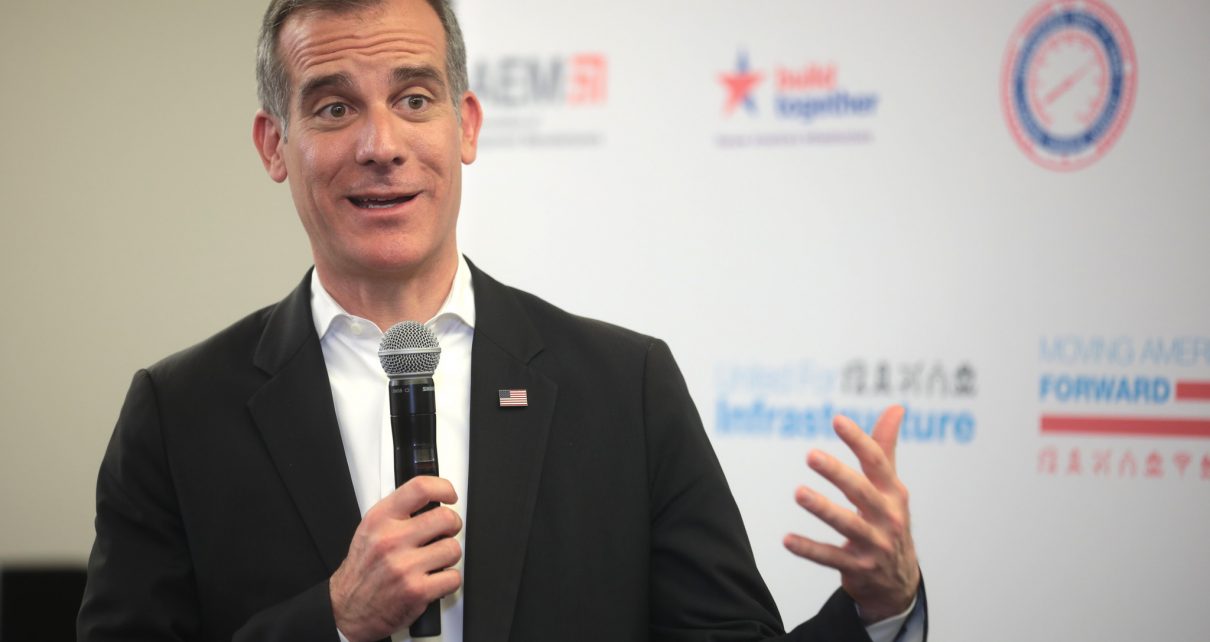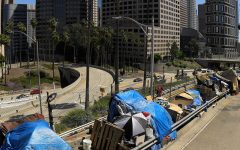
Mayor of Los Angeles Eric Garcetti speaking at Moving America Forward Forum, at UNLV. (Photo: Gage Skidmore)
Mayor Garcetti Announces Return of Project Roomkey to Los Angeles
With election of Joe Biden, project to ‘house hundreds’ in hotels, funded entirely by FEMA
By Evan Symon, February 4, 2021 8:42 pm
Los Angeles Mayor Eric Garcetti announced Wednesday that Project Roomkey, a program that houses at-risk homeless people during the COVID-19 pandemic, would be making a comeback in the city, with FEMA reimbursing the city 100% of the costs.
Project Roomkey began in April 2020 as a way to house the homeless population in California in hotels to avoid contracting COVID-19. The federal government paid most of the costs through FEMA, around 75%, leaving California to pay the rest of the $100 million project.
The program largely failed, however, due to a lack of homeless people signing up despite food, shelter, and some health costs being paid for. At it’s peak in 2020, Project Roomkey only filled 7,000 of the 17,000 hotel rooms put aside. While Northern California cities did see occupied percentages go above 50%, Southern California rooms didn’t have nearly as many takers. In Los Angeles, the occupied percentage never reached above 30%. FEMA started to waive it’s funding in September, causing the program to shut down, with the final rooms to be unrented by this month.
However, after the election of Joe Biden, FEMA funding for many homeless housing programs during the pandemic suddenly changed. Last week, President Biden announced that programs like Project Roomkey would be getting a 100% reimbursement from FEMA rather than the previous 75%, Los Angeles officials immediately jumped on that, with LA City Council members Mike Bonin, Marqueece Harris-Dawson, and Nithya Raman asking later that day that the city revive the program.
This led to Garcetti to announce on Wednesday the return of Project Roomkey to Los Angeles.
“Long before COVID, when I talked about the homelessness crisis, I always said we needed a FEMA-level response to a crisis that predates the pandemic, is involved in the pandemic and will postdate this pandemic,” Mayor Garcetti said on Wednesday. “And I was pleased that finally in the midst of this pandemic, we saw the opening of that door, with FEMA offering to help us get our unhoused neighbors off the streets.”
“I’ve instructed my team and the City Council has instructed our city government together to, with LAHSA (Los Angeles Homeless Services Authority), bring hundreds more Angelenos indoors by using those empty hotel and motel rooms across the Southland, and to find folks who are the most vulnerable and put them in shelter.”
The second round of Project Roomkey will have many of the same parameters as before, with only homeless who are 65 and older, or have a health condition that makes them vulnerable to COVID-19, allowed into the program. They will receive housing at hotels for 90 days, as well as meals, some health care access, and social service access to find permanent housing.
But while the cost burden will be shifted away from direct local payment, the programs expansion is drawing the ire of many in the Los Angeles area.
Issues with Project Roomkey Round 2
“They just tried this and they got barely anyone on board,” former county-homeless liaison Edgar Powe explained. “It’s good that they’re making it temporary now to get people into permanent housing, but they are still using a program that only sheltered, at it’s peak, 4,000 out of around 66,000 people in LA County. It’s better than nothing, but that was thousands of hotels left vacant. Let’s step away from the money involved and just put this on a human level. We had rooms, food, and everything all paid for for months and they didn’t fulfill over 2/3rds of it. On both a human and financial cost, that’s a lot of waste.”
“They need to actually house people this time. Really house people. A lot of people are already against this based on the federal cost, which is definitely in the millions again, and on the track record cost, because of the failings of last time.”
“Again, they have the right idea to bring people to permanent shelter and get them jobs to get off government assistance in a responsible way, with the added benefit of keeping senior citizens and those with medical conditions safe until the spring. But they are backing a program that failed before and set no initiatives or goals to get 90% and above in filled rooms.”
“To make this worthwhile, large blocks of housed homeless for the left, reducing the homeless population and associated government program costs by having them back paying taxes and going to work for the right, and protecting vulnerable people from COVID for all sides, there needs to be a program with accountability, clear goals, and ease of getting into the program. This just isn’t it. Notice Garcetti only said ‘hundreds’ too. Not thousands. Even they don’t expect to have a lot now.”
Los Angeles and Los Angeles County officials are expected to release new Project Roomkey plans in the next few weeks.
- Bill to Require Law Enforcement Disclosure if AI Was Used To Help Write Reports - August 7, 2025
- Gov. Newsom Files FOIA Request To ‘Expose True Cost’ Of L.A. Federal Troop Deployment for Anti-ICE Riots - August 6, 2025
- California Redistricting: How Newsom’s Plan Will Demolish Hard Fought GOP Gains - August 6, 2025





Another government boondoggle ripe for fraud…
In 3…2…1….
What a joke!!
As we all drive the streets and freeways of this state, the success of “room key” can be seen for miles. Tent cities are tripling in size! But hey, “project room key” sounds catchy so let’s keep going with it. Give a fool money and watch what he does with it!
Wake Up California!
What happens when you create these types of “housing programs” is the room rates tend to “daisy chain up.” This is what Gavin Newsom did in San Francisco with “care not cash:” They built a giant “front” of nonprofits each of whom bid for bulk rentals with a cartel of SRO rentals run by the Patel Family (Brahmins – just like Kamala). By playing off each nonprofit as master leases expired, the rates gradually increased in a “daisy chain” overseen by the City Controller Ben Rosenfeld. The City shuffled participants among hotels like on a monopoly board and then moved them between programs in the opposite direction. The result was to “racket” up the amount 1. billed to the city by the various nonprofits and 2. gained by the Patels in their “market rate.” The fact is, San Francisco was a monopsony (a market with a single purchaser), so the logical thing: negotiate with the Patels directly for a huge bloc of rooms and then assign these rooms to the nonprofit operators – didn’t happen. Now, I was working for one of these nonprofits and saw the kickbacks between the Patels and Gavin Newsom and Hillary Ronen – I even reported it but nobody would investigate. It happened in the form of the Patels buying expensive seats from the 49’ers they didn’t use (so they got purchased twice) and then the 49ers paying inflated license fees for the use of recorded music by the band of the son of a Nonprofit housing director who then kicked it back to the politicians. You could really tell the nonprofit was not sincere because the had a former forensic accountant and hotshot corporate CPA working for him and far below market salaries and because in spite of 20 years of operations there was no equity in the company and that the board consisted of the nonprofit director’s family members.
So, stepping back: what should be the case is General Assistance grants should be sufficient for basic shelter in an SRO. San Francisco’s homeless problem dates specifically from when Newsom and Willie started the SRO daisy chain in about 2002 or so.